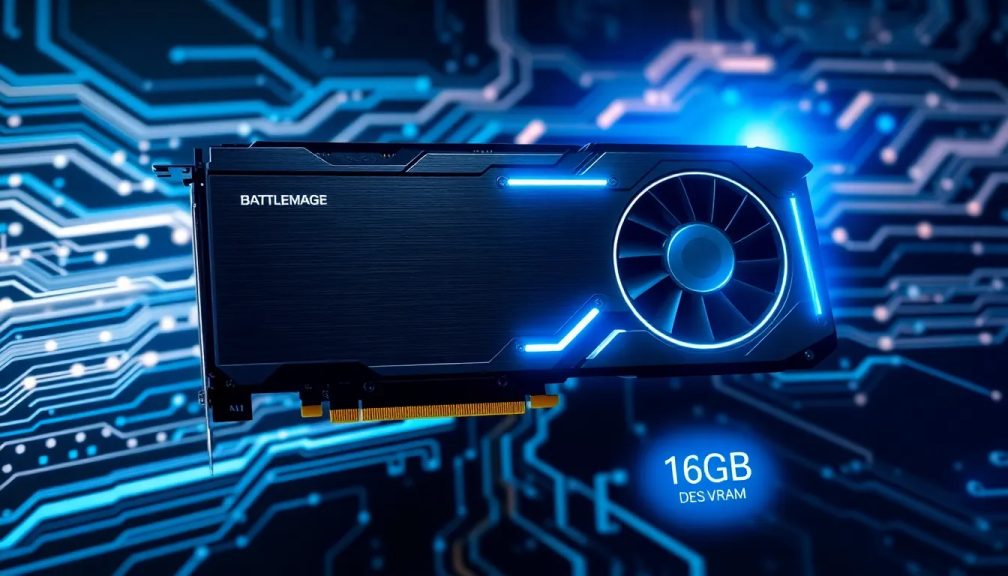Intel Arc Battlemage GPU with 16GB VRAM found in data log

The world of graphics processing units (GPUs) is constantly evolving, and Intel is making strides to capture a larger share of the market with its upcoming offerings. The potential introduction of the Intel Arc 'Battlemage' GPU with 16GB of VRAM has sparked excitement among gamers and tech enthusiasts alike. But what does this mean for the gaming landscape and Intel's position in the graphics market?
Understanding the Demand for Higher VRAM in Gaming
As gaming technology advances, the requirements for hardware performance have increased significantly. Modern games, such as Borderlands 4, are pushing the boundaries of what mid-range gaming systems can handle. This shift has led to a growing consensus that 16GB of video RAM is becoming the new standard for ensuring smooth gameplay and high frame rates.
Many gamers are now questioning whether 8GB of VRAM is sufficient for their needs. Factors influencing this decision include:
- The complexity of game graphics and environments.
- The resolution at which games are played (e.g., 1080p, 1440p, or 4K).
- The presence of multiple applications running concurrently during gameplay.
Leak of the Intel Battlemage e221 GPU
Recently, the “BATTLEMAGE e221” model was identified in a boot log by Twitter user Tomasz Gawroński. This leak suggests that the new card may correspond with the anticipated Arc B770, which comes equipped with a BMG-G31 processor and a robust 16GB of VRAM. This development hints at Intel's push to cater to the budget-conscious gamer by introducing a higher-end option.
Intel's strategy aims to create graphics cards that not only offer competitive performance but also affordability compared to leading brands like Nvidia and AMD. This is significant, especially given the rising prices of GPUs across the board.
Current Intel GPU Landscape
As of now, Intel has two models in its second-generation discrete graphics lineup: the B570 and B580, which come with 10GB and 12GB of RAM, respectively. Both models have been positively received, being seen as valuable alternatives to Nvidia and AMD offerings. However, the last new model was released in January, raising questions about the future of Intel's discrete graphics cards.
Intel's partnership with Nvidia, which integrates green-branded graphics into Intel processors, has led to speculation regarding the future of Intel's dedicated GPU line. Many industry observers are left wondering:
- Will Intel continue to prioritize its own graphics initiatives?
- How will this partnership impact the release of new discrete models?
Intel's Commitment to the Graphics Market
Despite the collaboration with Nvidia, Intel maintains that its roadmap remains unchanged. The company continues to release Battlemage cards aimed at industrial applications, likely in response to the growing demand for graphics capabilities in AI and machine learning.
However, with only a handful of desktop cards launched from the A series in the past two years, questions linger about the availability of higher-end Battlemage GPUs. Industry analysts are keen to see how Intel will balance its consumer and industrial product lines moving forward.
Anticipation for the B770 Model
The B770 model has garnered significant attention, but details remain sparse. The recent mention in a boot log is one of the few insights into its potential capabilities. Gamers and tech enthusiasts are eagerly awaiting more concrete information about this model, which is expected to fulfill the high-performance needs of modern gaming.
As the gaming community continues to grow, the demand for powerful GPUs with ample VRAM is likely to increase. Intel's entry into this space with the Battlemage series could mark a turning point for the company, allowing it to compete more effectively against established players in the graphics market.
For those interested in learning more about the Intel Battlemage GPU and its potential performance, check out this insightful video review:
This video provides an in-depth look at the specifications and expected performance of the Battlemage series, offering valuable insights for gamers considering their next hardware upgrade.
Conclusion
The emergence of the Intel Arc Battlemage GPU with 16GB of VRAM represents a significant advancement in Intel's efforts to penetrate the competitive graphics market. As gamers seek more powerful hardware to meet their needs, Intel's response with affordable, high-performance options will be crucial in shaping the future of gaming graphics.




Leave a Reply